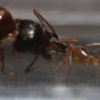This as a newbie is my very first colony... so a lot of reading and learning. Found a queen and five nanitics under a rock while searching for small colonies on 04-17-2016. I lost one while harvesting them (as in it wandered away), however they overall they weren't super active, so easily to capture in a couple test tubes. There was a clutch of eggs that one of the workers picked up, so was convenient when she walked into the test tube with them.
I couldn't really find a good way to move them into the test tube with the cotton ball/water, so currently using an Ants Canada Test tube portal, with water on one side, and the ants in the other.
I covered them initially for the first couple days to let them settle, first big mistake. When I checked on them, I noticed one of the workers had been eaten (just the gaster), so realized I should have fed them much sooner than I expected. I put in a couple drops of honey, and one of the works went over, gorged itself for a good 15-20 mins, went back and fed the queen, repeated, and this time fed the other workers in the nest. Was amazing how much their gasters swelled up to translucent.
After the first week all was going well, though noticed seemed like there was one primary worker that would forage, and the other two would guard the eggs. One ant is almost constantly on top of the eggs, a second ant tending that ant or the queen, and the third forages. So far they seem most active in the evenings, so observe them around this time of the night doing something (unless they are satisfied... more on that in a moment.)
I noticed after the first week the ant that did the primary foraging would hang out in the other tube, a LOT. I realized the water wasn't wicking too well thru the cotton ball. I pushed it in a bit more, she came over, drank, shared it with the colony, and went back to the rest of them and not overly active for a couple days.
After a few days the foraging ant was again hanging out in the other test tube away from the rest. Another rookie mistake and starting to realize they were indicating something was wrong. The honey had dried up they were feeding on and lost interest. Added another piece of honey, she again gorged herself on it, then went back into the other test tube with the rest.
I decided honey wasn't working too well, so ordered some of the ByFormica ant nectar off Amazon. Nectar arrived over this last weekend, I took a water bottle cap and cut it down and placed it in the middle section of the test tube portal with a few drops of the nectar. That evening, that same forager gorged herself, then fed the rest. Also noticed that all of their gasters were very much swollen afterwards, including the queens. Didn't realize how food deprived that had been when I compared the capture image above, to what they were before I added the nectar. Last few days they've been pretty fat and not overly active. Occasionally I catch the queen cleaning herself, etc. Have not yet feed protein, looking to do that next.
Have been working on designing a simple colony to print out based on some designs I found on Thingaverse inspired by the Ants Canada hybrid nest design. I still have some time before they are going to be large enough to move in, but don't want to be unprepared, especially as I'm overhauling the printer...
Notice the colony, even when hungry during my mistakes, had been taking meticulous care of their eggs. Slowly growing larger, but REALLY hard to see as there's constantly someone guarding them at all times.
Edited by noebl1, August 20 2016 - 1:26 PM.

















